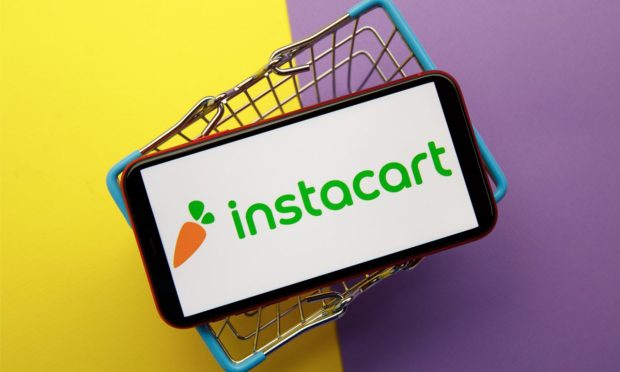Grocery Roundup: Instacart Launches New Gig Worker Rewards Program; Food Prices Rise

As the grocery industry struggles with labor shortages, especially when it comes to meeting delivery demand, leading third-party aggregator Instacart has been rolling out a slew of new features meant to attract and retain its in-store pickers and drivers.
The company announced Thursday (July 7) the launch of a new rewards program for its shoppers, Cart Star, through which they earn points for each order they fulfill. Shoppers who have a 4.7-out-of-five average customer rating and who have earned at least 200 points can access the program’s rewards, which include priority batch access.
“Our new Cart Star program was developed to celebrate and recognize top shoppers, delivering unique offerings and in-app functionality to enhance their shopper experience,” John Adams, vice president of shopper and fulfillment product at Instacart, said in a statement. “These new updates will reward top shoppers by increasing their access to batches and giving them more opportunities to earn.”
In addition to being able to earn priority batch access, shoppers can also redeem rewards for caregiving benefits — specifically, two days per quarter of discounted Backup Care through Care.com for $1 an hour or $10 a day.
“We know that in addition to the support they give to customers in their local communities, shoppers often have caregiving responsibilities at home, and we are excited to partner with Instacart to lend an extra helping hand when they may need it,” Ralph Bershefsky, vice president of client services at Care for Business, said in a statement.
In the recent past, a range of businesses across food and beverage sectors have been trying out internal rewards programs. For instance, some restaurants have been testing employee loyalty programs.
“It does two things: a currency with an incentive to keep them, but also a communication method,” Andrew Robbins, co-founder and CEO at Paytronix, told PYMNTS’ Karen Webster in a PYMNTS TV interview earlier this year.
Related: Restaurants Turn to eGift Cards to Smooth Bumps on Path to Recovery
Amid grocers’ labor challenges, the consumer demand for Instacart’s offerings remains and even grows. Research from the May edition of PYMNTS’ ConnectedEconomy™ Monthly Report, which drew from a survey of more than 2,600 U.S. consumers, revealed that the share of consumers using same-day grocery aggregators such as Instacart each month rose from 30% in March to 34% in April.
Read more: 19M More Consumers Went Online to Bank, Buy and Pay Bills in May 2022
UK Grocers Continue to See Costs Skyrocket
United States grocers may be struggling with rapidly rising food prices, but the U.S. is certainly not the only country dealing with these challenges. In the United Kingdom, for instance, grocers are also warning shoppers about price increases continuing indefinitely into the future.
As The Guardian reported Tuesday (July 5), Simon Roberts, CEO of Sainsbury’s, said that these issues would “only intensify,” noting a shift among shoppers towards purchasing less expensive products instead of name-brand items.
“We are seeing some switching into economy own-label, clearly as we expected, and that’s the reason why Sainsbury’s quality Aldi-price match is playing such an important role,” Roberts said, according to Reuters. “We are also seeing at the same time premium sales remaining resilient.”
The country’s Office for National Statistics report on consumer price inflation in May 2022, released in late June, reveals that prices for food and non-alcoholic beverages were up 8.7% year over year, which is lower than the overall Consumer Prices Index (CPI) increase, with prices rising 9.1% year over year.
In contrast, in the United States, the Consumer Price Index for All Urban Consumers (CPI-U), reported by the U.S. Bureau of Labor Statistics (BLS) in June, revealed that while prices for all items increased 8.6% year over year, food prices rose 10.1%, and grocery prices specifically jumped 11.9%.
Mastercard: Grocery Sales Outpace Price Increases
Grocery prices may be rising, but increases in consumers’ spending on groceries are outpacing inflation. According to Mastercard SpendingPulse data released Thursday (July 7), in June, grocery sales rose 14% year over year.
The gap between inflation and the increase in spending could come from a shift in how consumers are getting their food needs met. With rising prices, many could be cutting back on their restaurant spending in favor of more affordable food-at-home options, opting for price savings over the convenience of receiving a meal cooked by someone else.
On a call with analysts in late June discussing the company’s fourth-quarter FY2022 earnings, General Mills CEO Jeff Harmening commented on this shift.
Read more: General Mills Sees Inflation-Wary Consumers Shifting Away from Restaurants Towards Grocery
“When we saw this in the last recession, the Great Recession, we saw that consumption of away-from-home eating was down and replaced by at-home eating,” he said. “We’re seeing the same kind of behavior starting now … and that’s because customers want to get out more, but the cost of eating away from home is more than double the cost of eating at home.”
